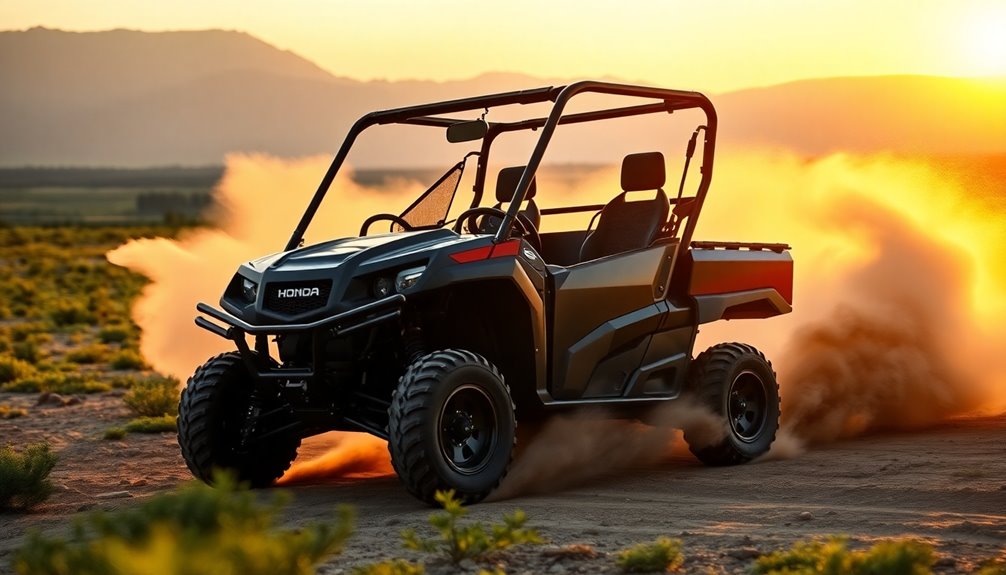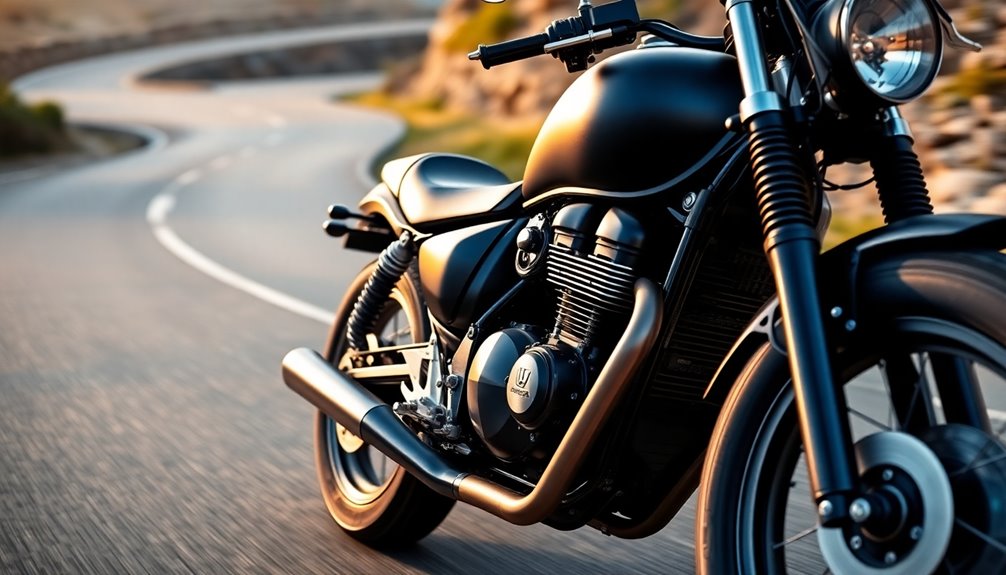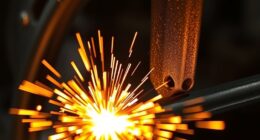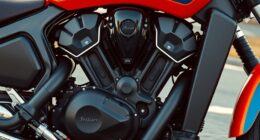The Honda Pioneer 700 tops out at 42 mph, making it perfect as both a workhorse and a weekend warrior. With a powerful 675cc engine delivering 36 horsepower, you'll tackle tough tasks and enjoy thrilling rides alike. Its three drive modes—2WD, 4WD, and 4WD with differential lock—offer versatility on any terrain. Plus, with a bed capacity of 1,000 pounds and a towing capacity of 1,500 pounds, it's ready for any job. So whether you're hauling gear or having fun, this side-by-side does it all. Explore further to discover more about its features and capabilities.
Key Takeaways
- The Honda Pioneer 700 achieves a top speed of 42 mph, making it suitable for both work and leisure activities.
- It features a powerful 675cc engine delivering 36 horsepower for efficient performance in various tasks.
- With a bed capacity of 1,000 pounds and a towing capacity of 1,500 pounds, it's versatile for workhorse duties.
- Three drive modes (2WD, 4WD, and 4WD with Differential lock) enhance adaptability for off-road adventures.
- The ergonomic design and long-travel suspension provide comfort for weekend outings while maintaining utility for work tasks.
Versatile Utility and Recreation Vehicle
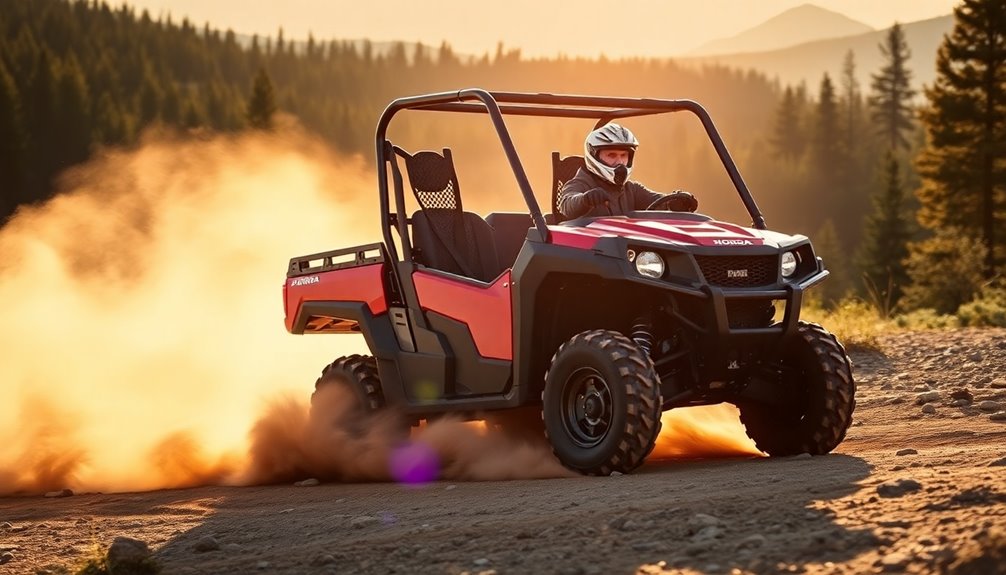
The Honda Pioneer 700 is an incredibly versatile utility and recreation vehicle that seamlessly blends practicality with fun. You'll find it excels both on the job site and during weekend adventures.
With a top speed of 42 miles per hour, you can zip around quickly, reaching full speed in about 20 seconds. The Pioneer offers three drive modes—2WD, 4WD, and 4WD with Differential lock—giving you the flexibility to tackle various terrains. Additionally, its acceleration from 0 to 42 mph takes around 20 seconds, making it suitable for most farm and utility applications.
When it comes to utility features, the Pioneer's bed capacity is an impressive 1,000 pounds, and it can tow up to 1,500 pounds, making it a reliable workhorse. With a ground clearance of 10.7 inches, you won't have to worry about rough paths.
Plus, its 14.8-foot turning radius allows for easy maneuverability in tight spots.
Safety and comfort are prioritized, too, with a robust protection structure, handrails, and three-point seatbelts. The tilt feature on the steering wheel and the LCD instrument display enhance your driving experience, ensuring you stay informed while you drive.
Whether you're working hard or playing hard, the Honda Pioneer 700 delivers exceptional performance.
Maximizing Engine Efficiency
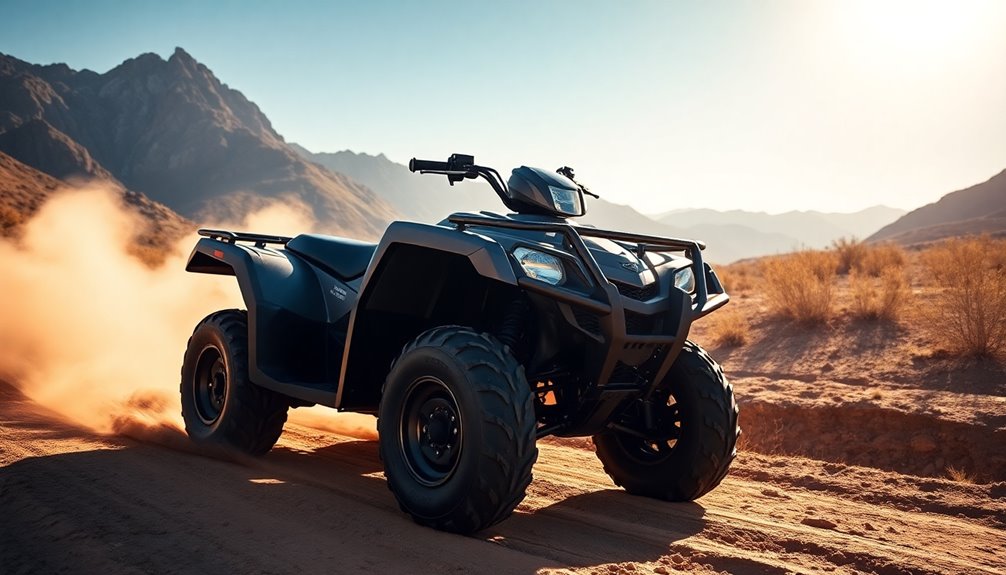
To maximize your Honda Pioneer 700's engine efficiency, focus on factors like maximum speed, throttle response time, and the type and size of your tires. Understanding how these elements interact can help you achieve optimal performance while maintaining fuel economy. Additionally, consider the benefits of the 675cc liquid-cooled engine, which provides robust power for various tasks and contributes to overall efficiency.
Maximum Speed: 40 Mph
Achieving optimal performance in the Honda Pioneer 700 means understanding its maximum speed, which is approximately 42 miles per hour. This top speed is governed by a rev limiter, designed to prevent the vehicle from exceeding that limit. While it might seem like a restriction, this feature is crucial for ensuring your safety and the efficient operation of the machine.
The Pioneer 700 is powered by a robust 675cc liquid-cooled single-cylinder four-stroke engine, incorporating a fuel injection system with a 40mm throttle body. This setup boosts engine efficiency, allowing you to maintain that top speed comfortably. Additionally, the vehicle's towing capacity of 1,500 lbs. makes it highly functional for utility tasks.
With an automotive-style automatic transmission and hydraulic torque converter, shifting between three forward gears and reverse is smooth and effortless.
Whether you're using it for work or play, understanding this maximum speed helps you make the most of its performance capabilities. The dual-mode transmission in the Forest and Deluxe models offers added flexibility, letting you choose between manual electric shift or fully automatic options.
Ultimately, the Pioneer 700 strikes a perfect balance between power, efficiency, and practicality, making it an ideal choice for various tasks.
Throttle Response Time
How can you maximize throttle response time in your Honda Pioneer 700? Start by ensuring that your throttle position sensor is functioning correctly. If it's malfunctioning, it can lead to stalling when you apply throttle, which affects your ride.
Regularly check the camshaft and valve adjustments; a bad cam can significantly hinder throttle responsiveness. If your engine enters limp mode, it's crucial to address any underlying mechanical issues quickly, as this can throttle your power delivery and efficiency. Additionally, a clogged air filter can also impact throttle performance, so make sure to inspect it regularly.
Using the automatic transmission effectively also helps. The hydraulic torque converter allows for smooth power transfer, but if you're looking for more control, consider the manual electric shift available in Deluxe models. This feature lets you override the automatic mode using paddle shifters, giving you a more direct connection to the engine.
Lastly, keep your Honda Pioneer 700 well-maintained with routine diagnostic checks. If you notice any unusual behavior but don't see a check engine light, it could signal problems that need attention.
Tire Size and Type
Selecting the right tire size and type for your Honda Pioneer 700 can significantly boost engine efficiency and enhance your driving experience. The stock tires, measuring 25 inches in diameter for the front (8 inches wide) and 25 inches for the rear (10 inches wide), are designed for versatility, balancing on-road comfort with off-road capabilities. Additionally, it's important to note that the bolt pattern for Pioneer 700 is 4×110, which is essential when considering aftermarket wheel options.
If you frequently navigate muddy or rocky terrains, consider investing in off-road tires. They provide superior traction, ensuring you maintain control and stability. Conversely, if you spend more time on pavement, on-road tires will offer a smoother ride and improved handling.
You can also explore upgrades, like 14-inch wheel kits or custom tire options. Upgrading to larger tires, such as 28-inch models, can enhance your off-road performance and aesthetics. Make sure to select reputable brands, like GBC, Maxxis, or STI, to ensure quality.
Lastly, pay attention to wheel specifications, including the 12mm lug nut size and 4×110 bolt pattern. Proper tire size and type not only maximize your engine's efficiency but also enhance overall performance, making every ride enjoyable.
Owner Feedback on Comfort
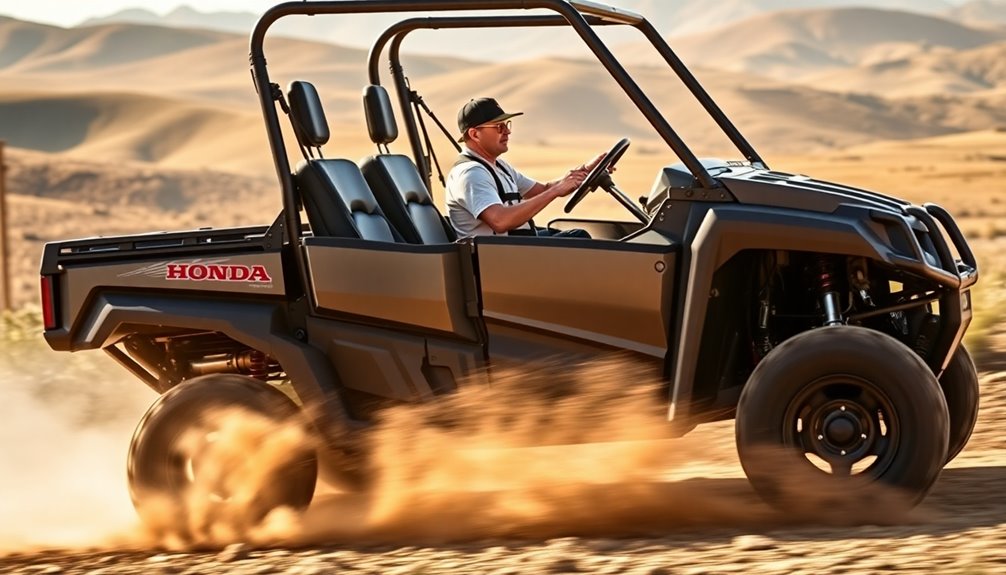
Owners of the Honda Pioneer 700 often rave about its comfort features, noting how the QuickFlip® seating design makes it incredibly versatile for different passenger needs. You can easily configure the seating for 2, 3, or 4 people, allowing for flexible arrangements based on your adventure.
When you need more cargo space, the seats can fold away, giving you a full bed area.
The ergonomic design enhances your driving experience as well. The tilt steering wheel adjusts to fit your comfort level, simplifying how you get in and out of the vehicle. You'll appreciate the front-door-mounted beverage holders and ample storage space in the glove box and under-dash.
With its long-travel suspension, the Pioneer 700 provides a plush ride over rough terrains. The independent suspension system, paired with adjustable preload shocks, ensures comfort even on challenging trails. The Pioneer 700 is powered by a 675cc fuel-injected engine, providing ample power for both work and recreation.
Owners enjoy the rugged styling that doesn't compromise the smooth ride.
Additional features like upsized cup holders and a 12-volt accessory receptacle in the bed make the Honda Pioneer 700 a practical choice for both work and play, ensuring you remain comfortable no matter the journey.
Owner Insights: Performance Experiences

Many drivers appreciate the Honda Pioneer 700 for its solid performance, especially when it comes to tackling various terrains. With a top speed of about 42 miles per hour, you'll find that it hits its rev limiter smoothly, allowing you to maintain control without feeling restricted. While it takes around 20 seconds to reach full speed from a dead stop, many owners agree that the current acceleration is adequate for everyday tasks, like navigating farm lanes. Practicing self-care can enhance your overall driving experience by keeping you focused and alert.
When it comes to off-road performance, you can rely on the Pioneer 700's 10.7 inches of ground clearance and aggressive Blackstone HP-007 tires for traction. It excels on rugged terrains, effortlessly handling holes, small limbs, and steep inclines, thanks to its standard ground clearance.
The 675cc engine, delivering 36 horsepower, paired with a three-speed automatic transmission, ensures a seamless driving experience. You'll appreciate the options for 2WD and 4WD, enhancing your traction in challenging conditions.
The versatility of the Pioneer 700 makes it ideal for both work and play. Whether you're transporting firewood or enjoying a weekend adventure, this vehicle adapts to your needs, proving it's a reliable companion for any task.
Market Positioning and Comparisons
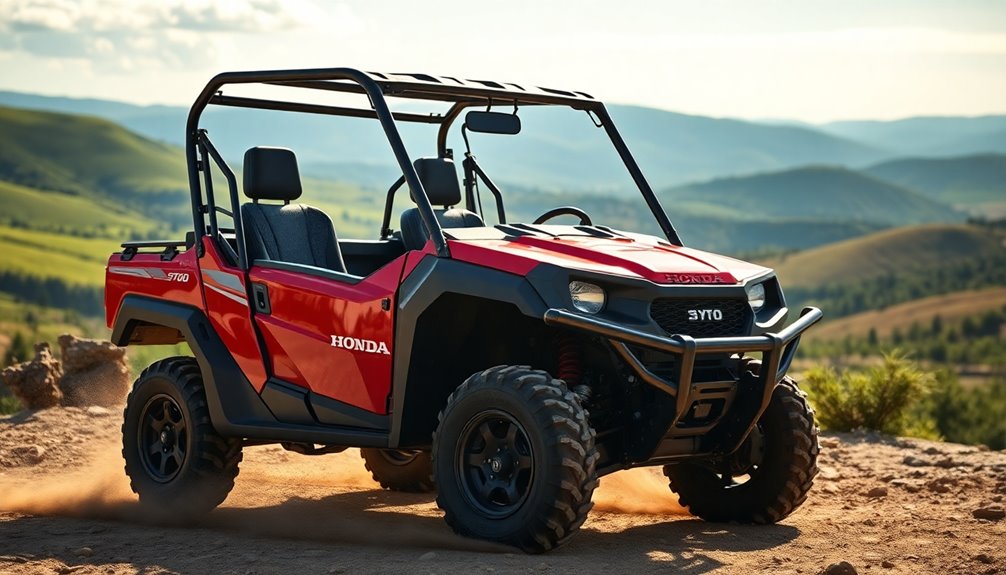
The Honda Pioneer 700 stands out as a well-balanced option in the rec/utility side-by-side market, offering a blend of power, torque, and agility. Positioned as the midpoint in Honda's lineup, it caters to both work and recreational users, making it versatile for any task.
You can choose from three trim levels: baseline, Deluxe, and Forest, and opt for either two- or four-seat configurations to suit your needs.
In terms of competition, the Pioneer 700 goes head-to-head with the Can-Am Defender and Polaris Ranger. Its rugged 675cc liquid-cooled engine, combined with an automatic transmission featuring a hydraulic torque converter, ensures robust performance.
With a 1,000-pound tipping capacity and 1,500-pound towing capability, it's built to handle heavy loads with ease. The Pioneer 700 is particularly advantageous due to its shaft drive system, which enhances durability and reliability compared to belt-driven models.
Thanks to its shaft drive system, you'll enjoy increased reliability and lower maintenance costs compared to belt-driven models. The Honda Pioneer 700 also boasts an exclusive lifetime engine warranty, setting it apart in terms of resale value.
With safety features like i-4WD technology and electric power steering, you'll find it not only reliable but also comfortable and easy to handle.
Performance-Enhancing Accessories
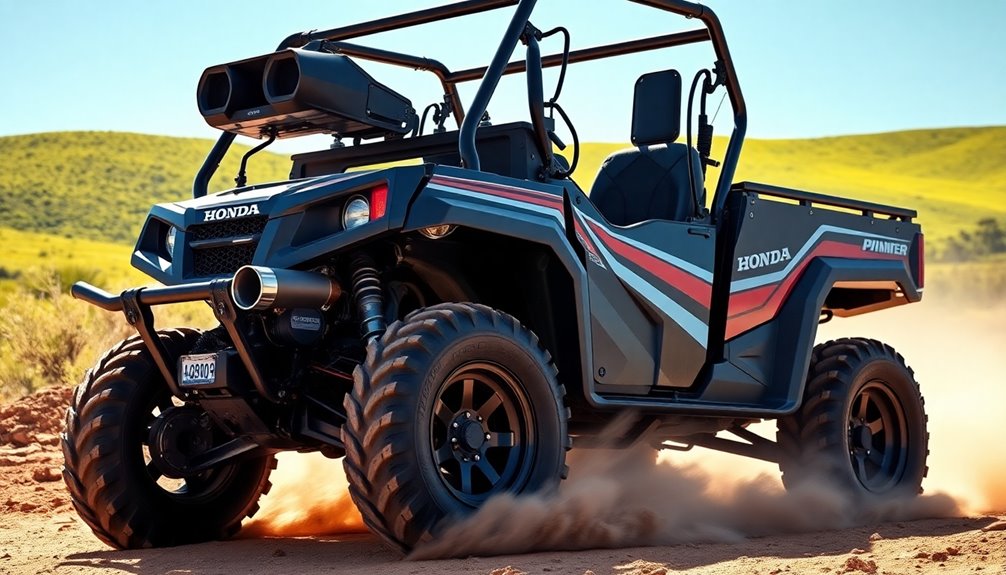
Often, enhancing the performance of your Honda Pioneer 700 can take your off-road adventures to the next level. Start with EFI controllers like the Attitude Box, which plugs directly into your factory wiring harness. It's designed to boost performance with load-based technology, giving you multiple tuning modes for easy adjustments on the fly. This load-based technology allows for fuel modification without altering the stock fuel map, ensuring optimal efficiency.
You'll notice a significant improvement in pulling power, especially on steep grades or when hauling extra cargo.
Next, consider suspension upgrades. High clearance A-arms can enhance your ground clearance and handling, while portal gear lifts—available in 2", 4", and 6"—improve your off-road capabilities.
These modifications reduce the risk of scraping the underside of your vehicle, ensuring a smoother ride in rugged terrains.
Don't forget about winches for recovery. Options range from 2,500 lb to 6,000 lb capacities, often featuring wireless remotes for convenience.
They're essential for overcoming obstacles and provide peace of mind during your adventures.
Finally, upgrade your lighting with LED light bars and bed lights for better visibility in low-light conditions.
These enhancements not only improve your ride but also add a personal touch to your Pioneer 700.
Cost and Dealer Locations

Upgrading your Honda Pioneer 700 with performance-enhancing accessories can be exciting, but understanding the costs involved is just as important. The base model has a Manufacturer's Suggested Retail Price (MSRP) of $12,499, with an additional destination charge of $1,185.
Keep in mind that this price excludes taxes, licensing, registration, and any dealer-installed options. If you're looking for more features, the Deluxe model starts at $14,099, while the Forest model comes in at $16,099, both with the same destination charge.
If you're in Canada, the Pioneer 700-4P DLX has an MSRP of $22,477 CAD. In addition, the Pioneer 700 has a towing capacity of up to 1,500 pounds, making it a versatile option for both work and play.
Finding a dealer to purchase your Honda Pioneer 700 is easy. You can use Honda's Powersports dealer locator tool by entering your zip code or location. Certified Honda Powerhouse dealers provide expert service and exclusive products in Honda-approved facilities.
They offer unique deals and foster a community for customers. Just remember, American Honda Motor Co. Inc. isn't responsible for any content found on independent websites, so stay cautious when exploring those options.
Examples of local dealers include SO CAL Honda POWERSPORTS and DEL AMO MOTORSPORTS OF LOS ANGELES.
Outdoor Enthusiasts and Farmers
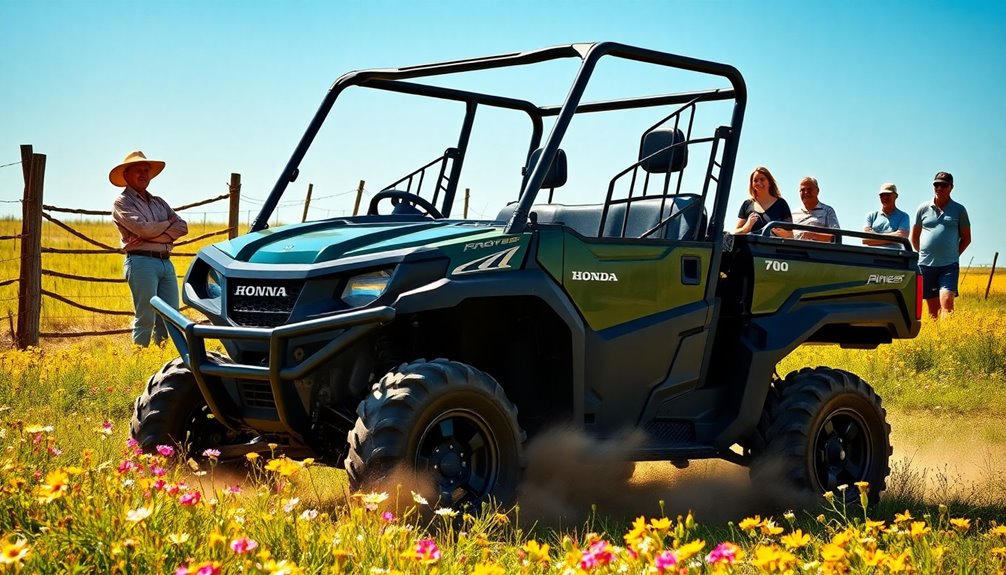
For outdoor enthusiasts and farmers alike, the Honda Pioneer 700 is a game-changer, offering a perfect blend of performance and versatility. With a top speed of 42 miles per hour and the ability to accelerate from a dead stop in about 20 seconds, it's ideal for trail riding and navigating moderate terrain. However, it's not meant for high-speed activities like dune riding or drag racing.
The Pioneer 700 shines in versatility, available in three trims: standard, Deluxe, and Forest. Its QuickFlip® seating converts to a flatbed, allowing you to transport cargo with ease. The generous 1,000-pound bed capacity and 1,500-pound towing capacity make it perfect for hauling everything from hunting gear to farm supplies. Additionally, the 675cc liquid-cooled single-cylinder engine provides the necessary power to tackle a variety of tasks efficiently.
For farmers, its robust engine and hydraulic assist strut ensure reliable performance for heavy-duty tasks. Safety features like the Occupant Protection Structure and three-point seatbelts give peace of mind during long days of work.
Plus, the adjustable preload rear shocks and automatic transmission make maneuvering through rugged terrain straightforward, whether you're on the farm or enjoying a weekend adventure. The Honda Pioneer 700 truly meets the needs of both outdoor enthusiasts and hardworking farmers.
Frequent Brake System Adjustments

While enjoying the versatility of the Honda Pioneer 700, it's important to stay on top of maintenance, especially when it comes to the brake system. Regular checks are crucial; inspect your front and rear brakes every 100 miles, 150 km, or 20 hours of use.
In dusty or muddy conditions, you might need to adjust them more frequently to prevent issues like binding or locking up. To adjust the rear brakes, ensure the lever has a freeplay of 9/16" to 13/16". Use the bottom wing nut to tighten or loosen as needed.
Don't forget to check your brake fluid levels monthly, as low fluid can lead to poor performance. It's also advisable to check for water in the drum, as trapped moisture can compromise braking efficiency.
Check your brake pads routinely; remove the caliper for inspection and ensure proper alignment with the piston and rotor. If your rear brakes bind after a short ride, repeated bleeding might be necessary. If problems persist, consider inspecting the master cylinder and rear rotor.
Including brake inspections in your maintenance schedule will help keep your Pioneer 700 functioning smoothly and safely, so you can focus on enjoying your adventures.
Robust Roll Cage Design
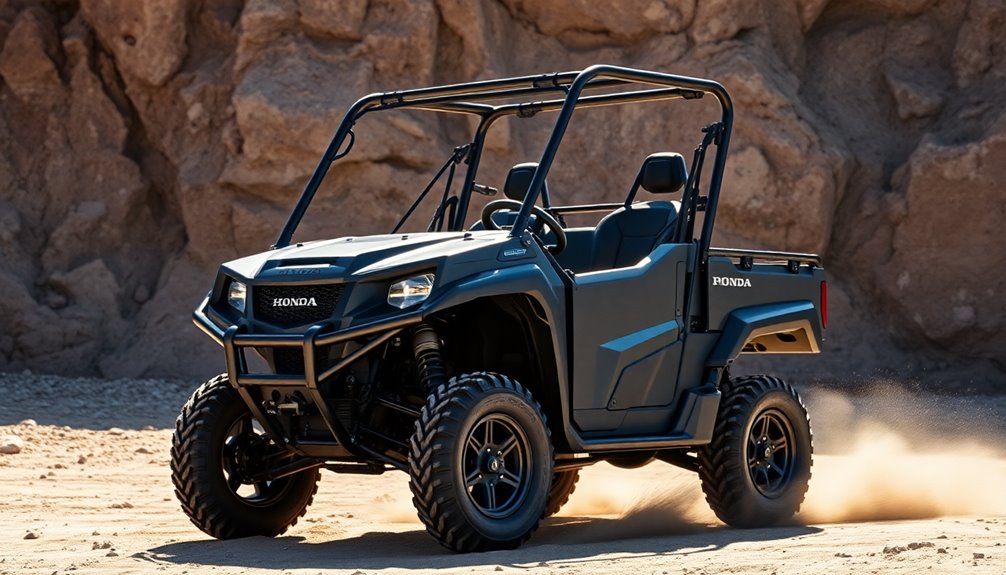
The Honda Pioneer 700 features a robust roll cage design that prioritizes your safety and stability on the trails. With a diameter of 1.625 inches (41.3mm) for the primary roll bars, vertical pillars, and horizontal support beams, this structure ensures maximum strength. It's engineered to withstand the rigors of both work and recreational activities, offering a durable construction that you can rely on. The integrated Rollover Protection Structure (ROPS) is a critical safety feature, complemented by standard three-point seat belts and side nets for additional passenger protection.
You'll appreciate how the roll cage design accommodates various accessories as well, with bar clamps fitting perfectly and rubber shims providing extra flexibility. Notably, the roll cage bars are consistent across the Honda Pioneer lineup, ensuring compatibility with a range of aftermarket accessories. For mounting, two-piece clamps are preferred to enhance fit and stability, ensuring everything stays secure while you navigate challenging terrains. If you're looking to customize, just remember that while accessories for 1.75-inch tubes can fit with some adjustments, the 1.625-inch components are the standard.
Impressive Off-Road Capabilities
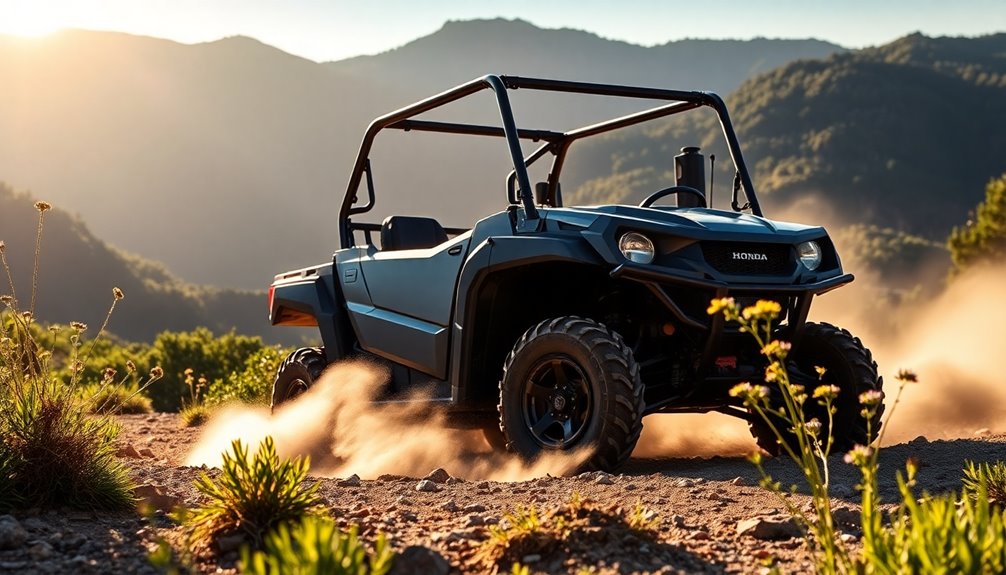
When tackling off-road adventures, the Honda Pioneer 700 truly shines with its impressive capabilities. Its robust 675cc liquid-cooled engine, paired with an automotive-style automatic transmission, ensures smooth power delivery whether you're navigating rocky trails or hauling heavy loads. The three hydraulic clutches and two-stage shift map optimize torque, making every ride feel effortless. Additionally, the Pioneer 700 is powered by a fuel-injected engine, providing dependable starts in various weather conditions.
The suspension system is another highlight. With an independent double-wishbone front suspension offering 7.9 inches of travel and a fully independent rear suspension with 9.1 inches, you'll experience superior handling even on uneven terrain. Adjustable preload rear shocks allow you to adapt to varying loads, ensuring a smooth ride every time.
When it comes to stopping power, the triple-disc brakes provide confidence on any surface. With 200mm front and 170mm rear hydraulic discs, you can trust the Pioneer 700's reliable braking system whether loaded or unloaded.
Plus, its impressive towing capacity of 1,500 pounds and 1,000-pound bed capacity make it a perfect workhorse for transporting gear. The hydraulic assist strut simplifies cargo handling, making the Honda Pioneer 700 the ultimate off-road companion.
Frequently Asked Questions
What Is the Honda Pioneer 700's Actual Top Speed?
The Honda Pioneer 700's actual top speed is around 42 miles per hour, though it may drop to about 40 on slight grades.
This speed is limited by a governor, prioritizing reliability over raw speed.
If you're looking to increase that speed, consider modifications like taller tires or ECU tuners, but be cautious as they might risk engine damage and could void your warranty.
For most users, 42 mph is more than sufficient.
How Does the Pioneer 700 Handle Steep Inclines?
When you tackle steep inclines with the Pioneer 700, you'll appreciate its stability and traction.
It effortlessly handles 45-degree angles, thanks to its ground clearance and weight distribution. The 4WD mode, especially with differential lock, enhances your grip on loose dirt.
You can also switch to manual mode for better control. While it climbs well, remember that high elevations or heavy loads might challenge its performance a bit.
What Type of Fuel Does the Pioneer 700 Require?
The Pioneer 700 requires regular unleaded gasoline for optimal performance.
You can use fuel containing up to 10% ethanol, which won't harm the engine. Just avoid E85 and other alternative fuels, as they aren't certified and could cause damage.
Always refer to the owner's manual for specifics, and make sure to choose fresh, high-quality fuel that meets current regulations.
This will ensure your vehicle runs smoothly and efficiently.
Are There Any Common Issues Reported by Users?
Yeah, there are some common issues you might encounter.
Users often report power loss, especially on hills, which could stem from faulty spark plugs or clogged air filters.
Suspension problems can affect your ride quality, making it feel too stiff or soft.
Additionally, some models experience transmission slips or clutch overheating.
Don't forget to check the cooling system, as reversed fans can lead to overheating.
Regular maintenance can help you avoid these headaches.
How Does the Pioneer 700 Perform in Cold Weather?
In cold weather, you might find the Pioneer 700 struggles a bit at first.
Let the engine warm up for a few minutes before you hit the road to improve starting.
Once you switch to 4WD, you'll notice it handles deep snow well, maintaining traction.
Just keep in mind that it may take some driving to smooth out the engine's performance.
Regular maintenance, like spark plug upgrades, can also enhance cold-weather performance.
